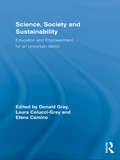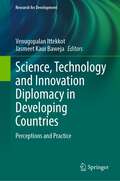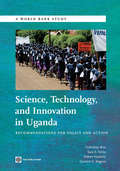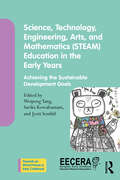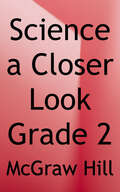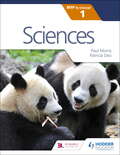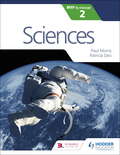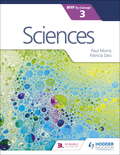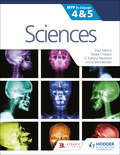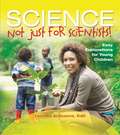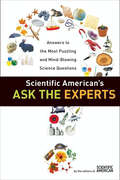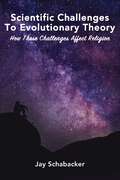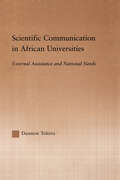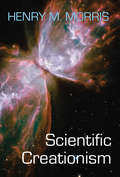- Table View
- List View
Science, Society and Sustainability: Education and Empowerment for an Uncertain World (Routledge Research in Education)
by Donald Gray Laura Colucci-Gray Elena CaminoRecent work in science and technological studies has provided a clearer understanding of the way in which science functions in society and the interconnectedness among different strands of science, policy, economy and environment. It is well acknowledged that a different way of thinking is required in order to address problems facing the global community, particularly in relation to issues of risk and uncertainty, which affect humanity as a whole. However, approaches to education in science tend to perpetuate an outmoded way of thinking that is incommensurable with preparing individuals for participation and decision-making in an uncertain, complex world. Drawing on experiences of interdisciplinary dialogue and practice in a higher education context, this book illustrates how reformulating the agenda in science and technology can have a revolutionary impact on learning and teaching in the classroom at all levels. This exceptional study will interest scholars in Education, Science, Technology, and Society, and those looking to further deliberative democracy and civic participation in their students.
Science, Technology and Innovation Diplomacy in Developing Countries: Perceptions and Practice (Research for Development)
by Venugopalan Ittekkot Jasmeet Kaur BawejaThis book provides a developing country perspective on the internationalization of science and the role of Science, Technology and Innovation Diplomacy (STID) in leveraging scientific cooperation for sustainable development. In articles by individuals from government departments and academic & research institutions in nine developing countries, it provides a conceptual understanding of the subject and reveals the prevailing perceptions on its praxis/practices. The articles highlight the significance of international cooperation at bilateral, regional and multilateral levels and the need for strengthening the role of STID in foreign policy and strategies of governments. The book is a useful reference material to government officials, diplomats,academicians, researchers, science counsellors, international relations experts, science and technology professionals and other stakeholders from the developing countries and transition economies, dealing with economic and developmental policy issues and/or science, technology and innovation (STI) issues in understanding the praxis and prospects of STID. The book is also useful for scholars and international relations experts from developed countries in understanding STI and related issues that affect the relationship of developing countries and transition economies with their partners from the developed world.
Science, Technology and Innovation in Uganda
by Sukhdeep Brar Robert Hawkins Sara E. Farley Caroline S WagnerScience, Technology and Innovation in Uganda is part of the World Bank Studies series. These papers are published to communicate the results of the Bank's ongoing research and to stimulate public discussion. This study presents a unique methodology to view science, technology and innovation (STI) in developing countries. The study provides a set of cases studies drawn from a diverse range of experiences across the Ugandan private sector and offers concrete policy recommendations on how to support broader development of STI in Uganda. The study finds that of all the STI challenges facing firms, universities, and public research organizations in Uganda, the barriers to collaboration and communication are the most urgent in terms of STI priorities to address in the coming years.
Science, Technology, Engineering, Arts, and Mathematics: Achieving the Sustainable Development Goals (Towards an Ethical Praxis in Early Childhood)
by Weipeng Yang Sarika Kewalramani Jyoti SenthilThis book provides a fresh perspective on recent debates around integrating STEAM (Science, Technology, Engineering, Arts, and Mathematics) education in early childhood. The book offers inspiration and practical advice for educators and researchers. It suggests concrete ways to engage young children in STEAM learning activities and promote their development. With contributions from international experts, the book discusses how to develop age-appropriate STEAM learning activities for young children. Divided into four parts, the book covers a wide range of topics, including the perceptions and practices of STEAM education among early childhood teachers in different countries, the use of new pedagogies and technologies to promote equitable and accessible STEAM education, the role of teacher education and policy in reducing inequality in STEAM education, and how early STEAM education can promote social change and achieve sustainable development goals. The book highlights the importance of STEAM education in providing young children with the necessary skills to create a more sustainable and equitable world. Overall, this book provides an important contribution to help critique and improve how early childhood educators view and practice STEAM education across cultures. It proposes ideas for achieving sustainable development goals through high-quality early STEAM education. The book appeals to early childhood educators and researchers, as it draws on cross-cultural viewpoints to critically examine how teachers understand and implement STEAM education across different cultures along with exploring how cultural values and goals shape early STEAM education.
Science: A Closer Look (Elementary Science Closer Look Series)
by McGraw HillThe Grade 2 Student Edition covers units such as Plants and Animals, Habitats, and Our Earth.
Science: Earth and Space
by Delores Shimmin Greg Parker DeWitt SteeleScience: Earth and Space has many features designed to make your study of earth and space science interesting and beneficial.
Science: Teaching School Subjects 11-19 (Teaching School Subjects 11-19)
by Keith S. Taber Vanessa KindIn recognizing that new teachers often feel disempowered by the subject expertise they bring into teaching, this book not only covers the training standards for NQTs and the Induction Standards, but takes the reader beyond this by fully exploring issues relating to subject knowledge in learning to teach.Divided into three sections the book covers: framing the subject - defining subject knowledge and focusing on questions about science as a school subject teaching the subject - looking at pedagogical, curricular and pupil knowledge science within the professional community - focusing on the place of science within the wider curriculum and the teaching community. This refreshing new book provides stimulating assistance to subject specialists, from new teachers of science in the early years of professional development to those on a PGCE course or in their induction year. It is also suitable for subject leaders with mentor responsibilities and Advanced Skills Teachers undertaking specialist inset and teaching support.
Science: Teaching School Subjects 11-19 (Teaching School Subjects 11-19)
by Keith Taber Vanessa KindIn recognizing that new teachers often feel disempowered by the subject expertise they bring into teaching, this book not only covers the training standards for NQTs and the Induction Standards, but takes the reader beyond this by fully exploring issues relating to subject knowledge in learning to teach. Divided into three sections the book covers: framing the subject - defining subject knowledge and focusing on questions about science as a school subject teaching the subject - looking at pedagogical, curricular and pupil knowledge science within the professional community - focusing on the place of science within the wider curriculum and the teaching community. This refreshing new book provides stimulating assistance to subject specialists, from new teachers of science in the early years of professional development to those on a PGCE course or in their induction year. It is also suitable for subject leaders with mentor responsibilities and Advanced Skills Teachers undertaking specialist inset and teaching support.
ScienceSaurus: A Student Handbook
by Great Source Education GroupScienceSaurus is a resource book and a student handbook that offers step-by-step guidelines and clear examples of key science topics that include Life Science, Earth Science and Physical Science.
Sciences for the IB MYP 1
by Paul Morris Patricia DeoExam Board: IBLevel: MYPSubject: ScienceFirst Teaching: September 2016First Exam: June 2017Develop your skills to become an inquiring learner; ensure you navigate the MYP framework with confidence using a concept-driven and assessment-focused approach to Sciences presented in global contexts.- Develop conceptual understanding with key MYP concepts and related concepts at the heart of each chapter.- Learn by asking questions with a statement of inquiry in each chapter. - Prepare for every aspect of assessment using support and tasks designed by experienced educators.- Understand how to extend your learning through research projects and interdisciplinary opportunities.
Sciences for the IB MYP 1
by Paul MorrisExam Board: IBLevel: MYPSubject: ScienceFirst Teaching: September 2016First Exam: June 2017Develop your skills to become an inquiring learner; ensure you navigate the MYP framework with confidence using a concept-driven and assessment-focused approach to Sciences presented in global contexts.- Develop conceptual understanding with key MYP concepts and related concepts at the heart of each chapter.- Learn by asking questions with a statement of inquiry in each chapter. - Prepare for every aspect of assessment using support and tasks designed by experienced educators.- Understand how to extend your learning through research projects and interdisciplinary opportunities.Contents1 What do scientists do?2 What changes?3 How do living things work?4 What makes change happen?5 How can we study the living world?6 Where do we fit into the world?GlossaryAcknowledgementsIndex
Sciences for the IB MYP 2
by Paul Morris Patricia DeoA concept-driven and assessment-focused approach to Sciences teaching and learning.- Approaches each chapter with statements of inquiry framed by key and related concepts, set in a global context- Supports every aspect of assessment using tasks designed by an experienced MYP educator- Differentiates and extends learning with research projects and interdisciplinary opportunities- Applies global contexts in meaningful ways to offer an MYP Sciences programme with an internationally-minded perspectiveContents list1 Where are we now and where are we going? 2 How do we map matter?3 Who are we? 4 How can we find out? 5 How does our planet work?6 How do we respond to our world?
Sciences for the IB MYP 2
by Paul Morris Patricia DeoExam Board: IBLevel: MYPSubject: ScienceFirst Teaching: September 2016First Exam: June 2017Develop your skills to become an inquiring learner; ensure you navigate the MYP framework with confidence using a concept-driven and assessment-focused approach to Sciences presented in global contexts.- Develop conceptual understanding with key MYP concepts and related concepts at the heart of each chapter.- Learn by asking questions with a statement of inquiry in each chapter. - Prepare for every aspect of assessment using support and tasks designed by experienced educators.- Understand how to extend your learning through research projects and interdisciplinary opportunities.Contents list1 Where are we now and where are we going? 2 How do we map matter?3 Who are we? 4 How can we find out? 5 How does our planet work?6 How do we respond to our world?
Sciences for the IB MYP 3
by Paul Morris Patricia DeoA concept-driven and assessment-focused approach to Sciences teaching and learning.- Approaches each chapter with statements of inquiry framed by key and related concepts, set in a global context- Supports every aspect of assessment using tasks designed by an experienced MYP educator- Differentiates and extends learning with research projects and interdisciplinary opportunities- Applies global contexts in meaningful ways to offer an MYP Sciences programme with an internationally-minded perspective
Sciences for the IB MYP 3
by Paul Morris Patricia DeoA concept-driven and assessment-focused approach to Sciences teaching and learning.- Approaches each chapter with statements of inquiry framed by key and related concepts, set in a global context- Supports every aspect of assessment using tasks designed by an experienced MYP educator- Differentiates and extends learning with research projects and interdisciplinary opportunities- Applies global contexts in meaningful ways to offer an MYP Sciences programme with an internationally-minded perspective
Sciences for the IB MYP 4&5: MYP by Concept
by Paul Morris Radia Chibani Kahina Meziane Anna MichaelidesDevelop your skills to become an inquiring learner; ensure you navigate the MYP framework with confidence using a concept-driven and assessment-focused approach to Sciences presented in global contexts.· Develop conceptual understanding with key MYP concepts and related concepts at the heart of each chapter. · Learn by asking questions for a statement of inquiry in each chapter. · Prepare for every aspect of assessment using support and tasks designed by experienced educators.· Understand how to extend your learning through research projects and interdisciplinary opportunities.· Think internationally with chapters and concepts set in global contexts.
Sciences for the IB MYP 4&5: MYP by Concept
by Paul Morris Radia Chibani Kahina Meziane Anna MichaelidesDevelop your skills to become an inquiring learner; ensure you navigate the MYP framework with confidence using a concept-driven and assessment-focused approach to Sciences presented in global contexts.· Develop conceptual understanding with key MYP concepts and related concepts at the heart of each chapter. · Learn by asking questions for a statement of inquiry in each chapter. · Prepare for every aspect of assessment using support and tasks designed by experienced educators.· Understand how to extend your learning through research projects and interdisciplinary opportunities.· Think internationally with chapters and concepts set in global contexts.
Sciences in the Universities of Europe, Nineteenth and Twentieth Centuries
by Ana Simões Maria Paula Diogo Kostas GavrogluThis book focuses on sciences in the universities of Europe in the nineteenth and twentieth centuries, and the chapters in it provide an overview, mostly from the point of view of the history of science, of the different ways universities dealt with the institutionalization of science teaching and research. A useful book for understanding the deep changes that universities were undergoing in the last years of the 20th century. The book is organized around four central themes: 1) Universities in the longue durée; 2) Universities in diverse political contexts; 3) Universities and academic research; 4) Universities and discipline formation. The book is addressed at a broad readership which includes scholars and researchers in the field of General History, Cultural History, History of Universities, History of Education, History of Science and Technology, Science Policy, high school teachers, undergraduate and graduate students of sciences and humanities, and the general interested public.
Sciencesaurus: A Student Handbook
by Great Source Education GroupThis book addresses key science topics including: scientific investigation; working in the lab; life science; earth science; physical science; natural resources and the environment; science, technology, and society. An ideal resource in science class, during lab time, and at home, this book also includes a handy almanac with tables, charts and graphs, test-taking and researching skills, science timelines and glossaries, and more.
Science—Not Just for Scientists!: Easy Explorations for Young Children
by Leonisa ArdizzoneChildren are natural scientists, drawn to wonder, exploration, discovery, and analysis. Science—Not Just for Scientists! gives you simple ideas to open up the world of discovery to young children. Through open-ended explorations, you will discover how to cultivate children's natural curiosity by asking simple questions: How? When? Where? And the most famous of all children's questions: Why? The hands-on activities will empower children to question, experiment, and develop abstract reasoning skills. Children will explore patterns, cause and effect, size and scale, change and growth, energy, and how things work. Easy to follow, step-by-step activities lead children and their caregivers through a new world of discovery. It's simple and fun to investigate: Patterns in Our Neighborhood Who Can Live Here? Big, Small, and In Between Simple Machines The Water Cycle Energy Path and so much more!
Scientific American's Ask the Experts: Answers to The Most Puzzling and Mind-Blowing Science Questions
by Editors of Scientific AmericanWhy is the night sky dark? How do dolphins sleep without drowning? Why do hangovers occur? Will time travel ever be a reality? What makes a knuckleball appear to flutter? Why are craters always round?There's only one source to turn to for the answers to the most puzzling and thought-provoking questions about the world of science: Scientific American. Writing in a fun and accessible style, an esteemed team of scientists and educators will lead you on a wild ride from the far reaches of the universe to the natural world right in your own backyard. Along the way, you'll discover solutions to some of life's quirkiest conundrums, such as why cats purr, how frogs survive winter without freezing, why snowflakes are symmetrical, and much more. Even if you haven't picked up a science book since your school days, these tantalizing Q & A's will shed new light on the world around you, inside you, below you, above you, and beyond!
Scientific Challenges to Evolutionary Theory: How these Challenges Affect Religion
by Jay SchabackerScientific Challenges to Evolutionary Theory: How These Challenges Affect Religion addresses all aspects of the giant battle between two major belief systems…those that believe in a &‘naturalistic worldview&’ and evolution, and those that believe in a miracle-performing God and the Creation of all things.On a trip to Mount St. Helens, some look at the catastrophic eruption of May 18, 1981 as a significant corroboration of the Creation event. Others, deniers of the possibilities of miracles, hold to the view that God&’s creation cannot be taken seriously by the scientific community.At the Mount St. Helens book store, I asked about books for sale that gave a Christian view of the catastrophic eruption. The reply was, &“I&’m sorry, sir, but we only carry books by scientists.&”It was time for the author, Jay Schabacker, to do a little scientific sleuthing. Join Jay Schabacker as you learn of the hundreds, even thousands, of Ph.D. scientists who repudiate the theory of evolution, but hold rather to the truth of the theory of Creation.Significant general information, likely new to most readers gives corroborative evidence from many sources, including:• From all over the ancient world, hundreds of accounts of a global flood• Well documented accounts of the Ark of Noah, indeed, located at the top of Mount Ararat• Ancient &‘Near East&’ finds, inscribed on rock, told of the actual details covered in the Holy Bible Numerous scientific papers refute the naturalistic dogma forced on us the government, public schools, universities and media. You&’ll find arguments that assert:• The earth&’s geological features appear to have been fashioned by rapid catastrophic processes that affected the earth on a global scale.• Life on earth was suddenly created, not over billions of years.• The use of radiometric dating method is often grossly in error.• The fossil record shows that all present living kinds of animals and plants have remained fixed since creation.• Mutations and natural selection are insufficient to have brought about any emergence of living kinds from a simple primordial organism.• The universe has &“obvious manifestations of an ordered, structural plan and design.&” The universe and the solar system were suddenly created. If evolution is wrong why are our children being only taught it in our public schools? Numerous polls favored biology teachers teaching Darwin&’s Theory of evolution, but also the scientific evidence against it. The final section of the book gets further into the &“Action Plan&” where church pastors and members, scientist groups, etc., could make an important difference if:• We all read about the subject and started the conversation;• We gave our views to the school boards and legislators who are the decision makers;• We initiate needed petitions in support needed legislation; and• We urge church pastors to create their own church schools and concerned families to start home schooling for their children.
Scientific Communication in African Universities: External Assistance and National Needs (RoutledgeFalmer Studies in Higher Education)
by Damtew TeferraFirst Published in 2003. Routledge is an imprint of Taylor & Francis, an informa company.
Scientific Creationism
by Dr Henry M. MorrisThe story of the origin of all things: Does the scientific evidence support special creation or atheistic evolution? Authoritative and thoroughly documented, Scientific Creationism is easily understood by readers with non-scientific backgrounds. Teachers, students, pastors, and other witnessing Christians can now be equipped with the convincing evidence for special creation. Updated and expanded, Scientific Creationism is a book that has changed the lives of people for Christ - people who have been blinded by the current origin-myth, evolution. "All ministers of the gospel, teachers and professors of our Christian schools on the primary and secondary level, should read this book. A copy should be placed in every church and school library, and used as a textbook in our Christian high schools and colleges."-Rev. C. Van Schouwen
